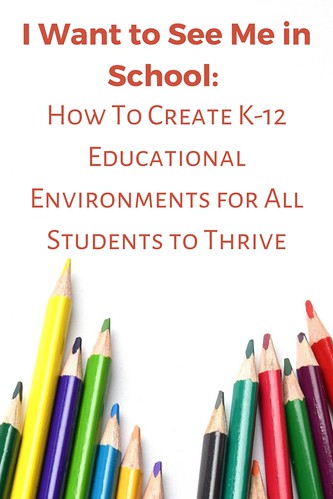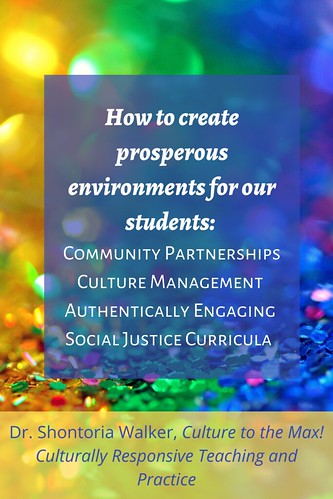When we think of creating educational environments for every student to thrive, what is usually the first thing that comes to mind? Schools that include an engaging curriculum. Classrooms that cultivate joy. Buildings that are lively and welcoming that offer a multitude of extracurricular activities and opportunities for students to explore the world through texts or field lessons outside of the classroom? Have we also considered creating spaces that elevate student voice and choice; that allow students to explore their identity; that grant them the opportunity to use their cultural references to make connections within the classroom?

In today's educational climate, leading a school towards success and achievement has proven to take on a new meaning. Beyond guaranteeing student’s health and safety, ensuring that school funding is appropriately allocated, and standardized testing expectations are met, leaders were presented with challenges of unwavering end to keep schools functioning throughout a historic shutdown caused by a global pandemic. Educators were tasked with managing classrooms, providing content, building background knowledge, assessing the needs of all students, and a myriad of other demands through virtual learning environments. As the COVID-19 restrictions subsided and students began to return to school in person after a year and a half, schools were expected to pick up where they left off in education, where there seemed to be a dissociation of the trauma and social isolation that many of our students experienced. Drastic changes to the state of education as we saw it, should call for drastic measures as we bear forward.
In focusing on cultural responsiveness for all students, whether in-person, hybrid, or virtual learning, culturally responsive pedagogy is the key to constructing meaningful experiences for students who may have spent their academic journeys feeling isolated from the curriculum and instruction year after year. Students who may have felt lost or forgotten and even struggled to find the connection and relevance to the material. Those that look like us and those that do not. As educators, we know that our students thrive in different environments. Therefore, we are responsible for creating that space for them to see success as attainable.
Culture To the Max! Culturally Responsive Teaching and Practice (2022) identifies practices K-12 educators, school leaders, and district leaders should consider beyond the obvious to ensure that their school allows all students to thrive. Here are a few elements to think about to create prosperous environments for our students:
1. Consider Community Partnerships as an integral part of schools and classrooms. The school should serve as a hub that gives back to the community and vice versa, where students can learn through contextualized experiences. How are we serving the community? How are local community leaders serving the school? Are they invited? Are the students aware of the historical significance of the community, whether they are from it or not? Are the educators aware? How often do the teachers drive to the school and go home without visiting the local barbershops, grocery stores, libraries, parks, or community centers?
2. Consider Culture Management over classroom management in every part of the educational environment. Effective culture management eliminates barriers to student learning.
3. Consider Authentically Engaging students through meaningful experiences that include student discourse, shared evaluation, rigor, and differentiation to meet the needs of all students.
4. Lastly, consider incorporating Social Justice Curricula within the instruction. This final consideration should not be diminished to indoctrination. Instead, it should be thought of as providing students with the tools and skills to impact change and advocate for themselves inside and outside of the classroom.

To effectively practice cultural responsiveness, educators must believe every student can succeed and every student's cultural background must be enthralled in the curriculum and instruction. Educators must also be aware of their own biases and how they may or may not impact classroom instruction and their approach to education as well as recognize how health, economic, and access disparities in a student's environment may impact their classroom learning abilities. An educator's attitude influences how they shape students' learning experiences. Now, I ask again, what comes to mind when we think of creating educational environments for all students to thrive?
Students deserve to see themselves reflected in their learning spaces. When we think of creating spaces for every student to thrive, culturally responsive pedagogy should be the priority in K-12 education.
Dr. Shontoria Walker is a graduate from the University of Houston in Houston, Texas with a degree in Professional Leadership with an emphasis in Literacy. Her research focuses on using culturally relevant pedagogy to influence literacy achievement for Middle School Black Male Students based on her experiences as a former 8th grade English teacher at an all-boys preparatory academy. She has also served on the Texas Teacher Advisory Board, a Teach Plus Policy Fellow as well as a Senior Policy Fellow with Teach Plus Texas from 2014-2019. During her time and beyond she has advocated for educational policy laws that directly impacted the classroom as well as contributed to policy briefings for the revision of The Every Student Succeeds Act and national policy reports, such as If You Listen, We Will Stay: Why Teachers of Color Leave and How To Disrupt Teacher Turnover. She is the co-author of Culture to the Max! Culturally Responsive Teaching and Practice along with David McDonald, M.ED., Danielle Ross, M.ED., and Andre Ross, M.ED.
